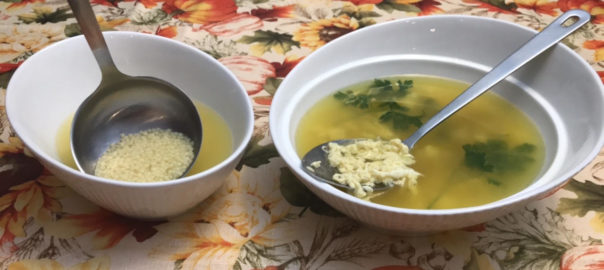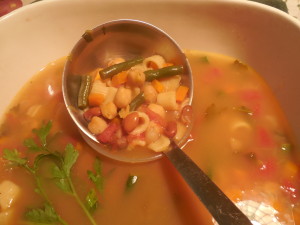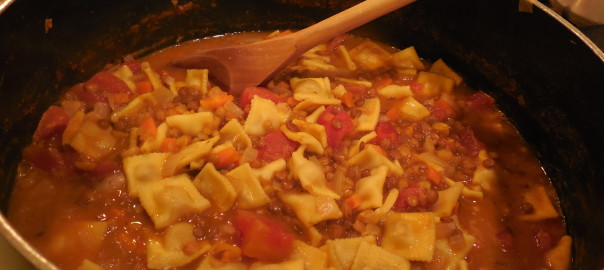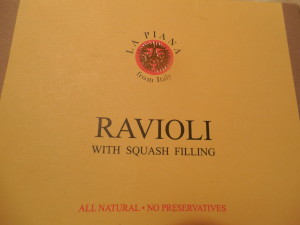Italian Chicken Broth: Egg Drop Soup or Pastina Stars
Italian chicken broth with wispy strands of eggs is called “Egg Drop Soup” at my family’s home but is known better as Stracciatella, or “Rags Soup.” For the perfect children’s chicken soup, instead add tiny pastas called pastina stars to your homemade chicken broth. Which is better? Make them both and you decide!
Italian Chicken Broth: Egg Drop Soup or Pastina Stars
When I was a child, my mother’s chicken soup was a welcome treat that accompanied the cool breezes of fall and sustained us through the cold winter months. We children loved when she returned home from the “chicken farm” down the road with stewing chickens because we knew that her delicious chicken soup would soon follow!
Italian chicken soup starts with a hearty chicken broth, or “brodo.” Chicken broth is simplicity to make, with just a few ingredients most home cooks have around the house. My mother would drizzle beaten eggs into her chicken broth to make wispy yellow strands of scrambled eggs, for “Egg Drop Soup” as my family called it, also known by its more traditional name of “Stracciatella “ or “Rags Soup.” And, I think every Italian adult has fond memories of their lunches at home as a young child, especially when they discovered tiny star-shaped “pastina” pastas in their chicken broth for “Pastina Soup!”
To make the most flavorful Italian chicken soup, start with a broth made with “stewing” chickens. Stewing chickens are the older, tougher chickens that will soften but not loose their flavor entirely and make a nice broth after even just 1 to 1 1/2 hours of cooking in liquid. The meat of stewing chickens usually can be removed from the bones and added to the soup if desired. Younger frying or broiling chickens can also be used to make chicken broth, but in this case the cooking time should be increased to 2 or 3 hours and by this time most of the chicken’s flavor will have been given up to the soup, rendering the chicken flavorless.
Italian moms know that adding a small tomato will make the chicken broth sweeter, a small potato will add a little starch for body, and if you leave the outer leaves on the onion the broth will become a golden color. Try my family’s simple method and I’m sure your children will agree: Italian chicken soup is the quintessential comfort food!
—Kathryn Occhipinti
Italian Chicken Broth with Egg Drop Soup or Pastina Stars
Italian Chicken Broth or “Brodo”
Ingredients
(Makes about 16-18 cups)
1 stewing chicken, 3-4 lbs., rinsed, quartered
with fat trimmed off
4 carrots, rinsed and chopped coarsely
2 celery sticks, rinsed and cut in half
1 onion, (skin on or off), rinsed and cut in half
1 small tomato, quartered
1 small waxy potato (not russet), yellow or red
Optional: Small bundle of fresh parsley stalks from garden
salt to taste
Method for Italian Chicken Broth
Rinse the stewing chicken well. Ask the butcher to quarter it for you, or cut the chicken into quarters if needed. Rinse again to clean off again.
(Additional step if desired to give a clearer broth: Pre-cook the chicken briefly: Put chicken in a pot of cold water and bring to the boil slowly. Skim off the foam that comes to the top, then discard the water and continue with the rest of the method.)
Place the quartered chicken into a large soup pot. Add cold water 3/4 to the top of the pot.
Add the carrots, celery, onion, tomato and potato.
Bring to the boil and then quickly turn down heat to keep the broth cooking at a simmer.
Continue to cook the soup uncovered. Skim off any “skuzz” or “foam” that floats to the top periodically, but do not stir the broth, which will yield a cloudy soup.
When the soup has cooked down to desired flavor — at least 1 1/2 to 2 hours, remove the chicken and the vegetables.
Taste the chicken and if it remains flavorful, remove it from the bones and reserve the meat to add to the soup if desired. The vegetables will usually lose all their flavor and should be discarded and new, finely-chopped vegetables added to the finished soup. (If not, the soup should probably be cooked for a little longer time, but that is of course a matter of taste!)
Strain the broth to remove any small particles that may have formed.
(Additional step that can be omitted: If you do not need the broth right away, or if on a low-fat diet, store the strained broth in a pot in the refrigerator. By the next day, the fat will have floated to the top and hardened and can easily be skimmed off with a spoon.)
Add salt to the broth as desired and then finish as below and make into a soup.
Italian Egg Drop Soup
Ingredients
(Makes about 4 cups)
4 cups Italian chicken broth, homemade or canned
2 eggs, beaten lightly
1/4 cup finely grated Parmesan cheese
salt to taste
Optional: Fresh parsley stalk and leaves from garden for garnish
Method for Egg Drop Soup*
Use a small bowl or large measuring cup with a spout, if possible. Mix the eggs and Parmesan cheese together lightly.
Place the 4 cups of cold chicken broth into a pot that can hold about 6 cups.
Adjust salt as desired.
Use medium-low heat to gradually bring the broth to a boil. Watch closely as the broth comes to a boil.
When small bubbles start to appear, and the broth is almost at a simmer, while mixing, drizzle the egg/cheese mixture into the pot slowly, allowing the eggs to cook briefly before adding more of the mixture.
When all egg has been added and partially cooked, mix lightly with a fork to keep the egg separated until the egg has completely cooked.
Watch the Instagram video below to see this method in action!
*For an alternative method, that will yield small strands of egg mixed more completely into the soup, called Stracciatella soup, omit the Parmesan cheese. Mix about 1 cup of the warm broth into the lightly mixed eggs and then pour all of the egg/broth mixture into the warm broth. Bring to a boil and watch the smaller egg strands form.
To make larger “rags,” omit the Parmesan cheese and very lightly beat the egg mixture so that some of the white remains visible. Bring the soup to a low boil, and drizzle in the egg mixture a bit at a time while stirring gently with a fork.
When the egg is cooked through, it is ready to eat, topped with Parmesan cheese of course!
Italian Pastina Soup for Children
Ingredients
(Makes about 4 cups)
4 cups Italian chicken broth, homemade or canned
1/3 cup pastina (little stars) pasta
Method for Pastina Soup for Children
For 4 cups of chicken broth, use 1/3 cup pastina star pasta
Place the 4 cups of cold chicken broth into a pot that can hold about 6 cups.
Cook as you would for any other pasta:
Set the chicken broth on the stove over medium high heat and heat to a rolling boil.
Add salt to taste, cover, bring to boil again, and then uncover and add pastina pasta.
Stir pasta, cover and bring to a boil again.
Take cover off and stir.
Let the pasta cook until al-dente (“to the tooth”). In this case, you will see the pasta stars grow. When pasta has finished cooking, ladle the soup into a bowl .
Present to small children with Italian bread for a warm and satisfying lunch!
— by Kathryn Occhipinti
Kathryn Occhipinti, MD, is the author of the
Conversational Italian for Travelers series of books and a teacher of Italian for travelers to Italy in the Peoria and Chicago area.
“Everything you need to know to enjoy your visit to Italy!”
Join my Conversational Italian! Facebook group and follow me on Twitter at StellaLucente@travelitalian1 and start to learn Italian today for FREE!
Conversational Italian! Facebook Group
Tweet @travelitalian1 for Stella Lucente Italian
YouTube videos to learn Italian are available from © Stella Lucente, LLC.
Learn Conversational Italian.
More information on and photographs of Italy can be found on Facebook Stella Lucente Italian and Pinterest Stella Lucente Italian.
Facebook Stella Lucente Italian
Pinterest Stella Lucente Italian
Visit learntravelitalian.com/download.html to purchase/download Conversational Italian for Travelers and find more interesting facts and helpful hints about getting around Italy! Learn how to buy train tickets online, how to make international and local telephone calls, and how to decipher Italian coffee names and restaurant menus, all while gaining the basic understanding of Italian that you will need to know to communicate easily and effectively while in Italy. —From the staff at Stella Lucente, LLC
Italian Chicken Broth: Make Egg Drop Soup or Make it with Pastina Stars





